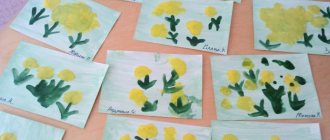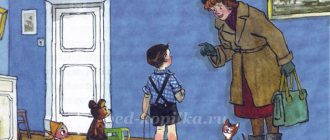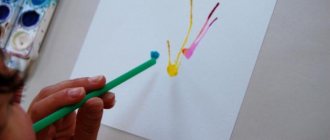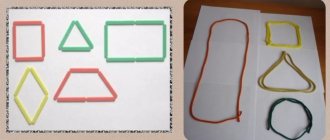Table: card index of topics on labor activity in the senior group of preschool educational institutions
| Author | Savina P.I. | |||
| Type of labor | Subject | Tasks | Examples of work | Note |
| Household labor | "Cleaning up closets and shelves" |
| Try to encourage your children to clear out bookshelves or organize toy cabinets. | Tell the kids a story about slobs and explain that they shouldn’t do that. |
| "Neatly made beds" |
| After quiet time, talk to your children about the importance of keeping their bed tidy. Explain to them in a playful or fairy-tale way about the germs that can appear in the bed if it is not made. | You can cut out figures of microbes from cardboard and place them on the bed of a child who has not made it. | |
| Labor in nature | "Water the plants" |
| Invite the children to take care of the indoor flowers that are in the group. If there are no such flowers, then you can take the children outside and talk about watering plants using the example of street bushes, grass or flower beds. | You can imagine the watering can as a “cloud”. Thanks to this, you will not only show children the principle of working with plants, but also explain what rain is. |
| “Wet wiping of leaves of large-leaved plants” |
| Teach children about the dust that flies in the air and settles on plants. Explain to them how to carefully wipe the leaves. | Try using not only rags, but also damp sponges. They absorb liquid much better and stay wet. They are then easy to dry. | |
| Teamwork | “General work on the corner” | Learn to create collective crafts and figurines to decorate their “children’s corner.” | Use several types of creative materials: paints, pencils, plasticine, cardboard, etc. The main task of the teacher, in addition to instructing and explaining to children how to work, is to control all actions with dangerous tools. | Encourage children to paint with their fingers. You can help color their hands and put them on paper. |
| "Joint and general games" |
| Try playing the group game “Tea-Tea to the Rescue.” The player who will be the “driver” is selected. He runs after other guys and catches them. The child he touches becomes “bewitched.” Another player can touch the “bewitched” and free him. The game ends when all players become "bewitched". | Playing games with sports equipment such as balls or jump ropes is useful not only in terms of developing social skills, but also improves physical abilities. | |
| Self-service | “Independent search for answers to the question posed” |
| Ask your child a question like: “What was the name of the chicken that laid the egg?” Ask your child to find the answer in the story itself. This will prepare him well for future assignments at school. | Question options: “Where is Koshchei’s life hidden?”, “How many knights come out of the sea in Pushkin’s fairy tale?”, “Who is the mermaid?” |
| "Self-care" |
| Provide your child with a clothes brush and talk about how to properly clean clothes. Explain why this should be done (“to look neat”). | Try talking about how to keep your clothes in order so that you have to clean them as little as possible. | |
| Duty | "Duty in the dining room" |
| Select a few children and bring them to the dining room. Then tell them how to set the table and arrange the plates. After this, you can begin practical work and allow the children to do everything on their own. | Try to come up with some little incentives for those guys who were on duty especially well. |
| "Street duty" |
| Give a few kids brooms and offer to sweep the leaves off the paths if it's autumn. In winter, you can ask for help removing small piles of snow using shovels. And in the spring you can show the children how to water the flowers in the flower beds. | Always make sure that your child is assigned only work that he is definitely able to do. | |
| Handmade and artistic work | "Creating Crafts" |
| Try to gather a small group of children and make a plasticine craft with them. For example, the “Hedgehog” craft:
| This type of work allows the teacher to get to know the children better. |
| "Artwork" |
| Give children coloring books and provide pencils. | Try showing your children a few drawings that you can draw yourself. | |
Household work of preschool children
Larisa Deryabina
Household work of preschool children
Household work of preschool children.
Labor education of preschoolers is a purposeful process of developing in children a positive attitude towards work , the desire and ability to work , morally valuable qualities, and respect for the work of adults .
The origins of labor education lie in preschool age , when the child first begins to feel the need for independent activity, declaring his intentions and showing himself to be the subject of his desires and interests. Fostering this need is one of the central tasks of children’s labor education .
Recently, labor education; the priority is the intellectual development of the child. Work remains an episodic and secondary component of the lives of children in preschool educational institutions; there is no interaction between an adult and a child at the level of co-creation and assistance in work activities ; labor education does not become a leading direction in the educational process.
Tasks of labor education of preschool children :
1. Fostering a positive attitude towards the work of adults , the desire to provide them with all possible assistance.
2. Formation of labor skills and their further improvement, gradual expansion of the content of work activity .
3. Raising positive personal qualities in children: habits of work effort , responsibility, caring, thrift, readiness to take part in work .
4. Formation of skills for organizing your own and general work.
5. Nurturing positive relationships between children in the process of work - the ability to work cooperatively and amicably in a team, to help each other, to kindly evaluate the work of peers, to make comments and give advice in the correct form.
1. Types of work of preschool children .
The work of children in kindergarten is varied. This allows them to maintain their interest in activities and provide them with a comprehensive education. There are four main types of child labor :
Self-care is aimed at caring for oneself (washing, undressing, dressing, making the bed, preparing the workplace, etc.). The educational significance of this type of work activity lies primarily in its vital necessity. Due to the daily repetition of actions, self-service skills are firmly acquired by children; self-care begins to be recognized as a responsibility.
Household work of preschool children are not so noticeable in comparison with other types of labor This work is aimed at maintaining cleanliness and order in the premises and area, helping adults in organizing routine processes. Children learn to notice disturbances in order in a group room or area and, on their own initiative, eliminate them. Household work is aimed at serving the team and therefore contains great opportunities for developing a caring attitude towards peers.
Labor in nature involves the participation of children in caring for plants and animals, growing plants in a corner of nature, in a vegetable garden, in a flower garden. This type of work is of particular importance for the development of observation, nurturing a caring attitude towards living things, and love for nature. It helps the teacher solve the problems of children’s physical development, improving movements, increasing endurance, and developing the ability for physical effort.
Manual labor - develops children's constructive abilities, useful practical skills and orientation, creates interest in work, willingness to take on it, cope with it, the ability to evaluate one's capabilities, the desire to do the job better (stronger, more stable, more elegant, more accurate, aimed at satisfying the aesthetic needs of a person. This is the work of making crafts made from natural materials, paper, cardboard, fabric, develops fantasy, imagination, creativity, develops small muscles of the hands, helps develop self-control, the ability to complete a task.
In the process of work , children become familiar with the simplest technical devices, master the skills of working with certain tools, and learn to treat materials, objects of labor , and tools with care.
2. Household work of preschool children
Household work is the second type of labor that a child of preschool age is able to master. The contents of this type of labor are : labor for cleaning the premises ; washing dishes, laundry, etc.
Household work of preschoolers are not so noticeable in comparison with other types of their labor This work is aimed at maintaining cleanliness and order in the premises and area, and at helping adults organize routine processes. Children learn to notice any disturbance of order in a group room or area and, on their own initiative, eliminate it. Household work is aimed at serving the team and therefore contains great opportunities for developing a caring attitude towards peers.
In early preschool age, the teacher develops basic household skills : helping to set the table, tidying up toys after playing and washing them, collecting leaves on the site, sweeping snow from benches, etc. He necessarily evaluates the moral side of labor participation children : “Natasha and Seryozha helped our nanny well, what great guys!”, “Irochka is a caring girl, neat, how diligently she put away her toys!” Such assessments make children want to imitate their peers and contribute to the formation of ideas about how to act in such cases.
In the middle group, the content of household work expands significantly: children fully set the table, prepare everything necessary for classes, wash doll clothes, wipe dust off shelves, sweep paths in the area, etc.
Using their increased capabilities and taking into account the developed skills, the teacher accustoms children to the fact that in work it is necessary to make an effort, develops independence, initiative in performing activities
assigned tasks.
In the older groups of the kindergarten, household work is even more enriched in content and becomes systematic, largely turning into the permanent duties of those on duty. Children keep the room and area clean, repair toys and books, and provide assistance to children. The peculiarity of the household work of older preschoolers is the ability to organize it independently: select the necessary equipment, place it conveniently, put everything in order after work. In the process of work , children show diligence, a desire for a good result, and treat their peers kindly.
Gradually, children acquire independence in this type of work . The teacher uses methods of showing, explaining, discussing the work process and results , evaluating, teaching certain ways to perform labor operations (how to wring out a rag so that water does not flow down the sleeves, etc.)
.
It is important to form in preschoolers an idea of the importance of household work for everyone and for everyone personally. It is this work that makes it possible to show the child that he himself can make the environment in which he lives beautiful and pleasant.
The teacher always draws the children's attention to this side. If each of us cares about making everything around us beautiful, we will not be able to throw a piece of paper on the floor and, of course, will not draw on the wall or in the elevator. Only someone who doesn't love his home can do this. Thus, the ability to notice disorder and eliminate it without an adult’s reminders is developed. Modern household work is made easier by technology . There is also one in a preschool institution (vacuum cleaner, mechanical brush for washing windows, etc.)
At home, families have a washing machine, dishwasher, microwave oven, etc. The child sees how adults use such equipment.
It is useful to teach children to use household machines. At home, a child can vacuum the carpet on the floor and watch the washing machine in action. It is imperative to introduce children to safety rules and try not to leave them alone with equipment. But under the supervision of an adult and together with him, a child can, using equipment, engage in household work .
Practice shows that by older preschool age, some children lose interest in this type of work . The reason is that the child has already mastered the necessary skills. Children do everything that is required of them: wash toys, make beds, etc., but they do it without interest. The content of household work can be complicated by expanding the range of responsibilities or introducing a new object for the use of already developed skills (wiping dust not only in the toy closet, as has always been the case, but also on the windowsill, on furniture in the bedroom).
Household skills acquired by children in preschool are transferred to the family and vice versa.
Household work : Tasks and content of work in groups
1st junior group
1. Teach children to maintain order in the playroom and, at the end of the games, to place the play material in its place.
2. Involve children in performing simple labor actions . Together with an adult and under his supervision, place bread baskets (without bread)
and napkin holders.
2nd junior group
1. Encourage children to independently carry out basic tasks - prepare materials for classes (brushes, modeling boards, etc.)
; After playing, put away toys and building materials
2. Teach to maintain order and cleanliness in the premises and area of the kindergarten
3. Encourage to provide assistance to adults, to cultivate a caring attitude towards the results of their work .
4. In the second half of the year, begin to develop in children the skills necessary for serving in the dining room: helping to set the table for dinner (laying out spoons and forks, arranging bread bins, plates, cups, etc.).
Middle group
1. Teach children to maintain order in the group and in the kindergarten area: put away building materials, help the teacher, glue books and boxes.
2. Teach children to independently perform the duties of dining room attendants: carefully arrange bread bins, lay out cutlery (spoons, forks, knives)
.
Senior group
1. Teach children to help adults maintain order in the group: wipe toys and teaching aids, wash toys and building materials, repair books, toys
2. Develop the ability to clean up the kindergarten area: sweep and clear paths of debris, snow in winter, water sand in the sandbox
3. Teach children to independently and conscientiously perform the duties of the dining room attendants, to set the table, to clear away the dishes after meals.
4. Learn to independently lay out materials for classes prepared by the teacher, put them away, wash brushes, paint sockets, palettes, wipe tables
Preparatory group
1. Continue to teach children to constantly and timely maintain order in the group and on the site: wipe toys and aids, wash toys, building materials, repair books and toys together with the teacher.
2. Continue to teach how to independently restore order in the kindergarten area: sweep and clear paths of debris, snow in winter, water sand in the sandbox.
3. Learn to make your own bed after sleep
4. Accustom children to independently and conscientiously perform the duties of canteen attendants: fully set the table, distribute second and third courses (berries, fruits)
dishes, clearing dishes after meals, sweeping the floor
5. Learn to independently lay out materials for classes prepared by the teacher, put them away, wash brushes, paint sockets, and wipe tables.
By the end of the year, children can: organize their workspace and put it in order after classes are over.
Thus, it is necessary to note the variety of types of child labor in preschool educational institutions : self-service, household labor , labor in nature and manual labor . The share of certain types of labor at different age stages is not the same. Each of them has certain capabilities for solving educational problems, which allows them to maintain children’s interest in work and ensures their comprehensive development.
In order for children to work with pleasure , it is necessary to create an emotionally positive atmosphere. Properly organize the material environment and work equipment . Managing children's work activities requires the teacher to know the specifics of the child's development and upbringing, as well as the ability to actively promote the acquisition of the necessary skills. It is important to take into account the load, avoiding overloading children. It is imperative to take into account the individual interests and inclinations of children for one or another type of work .
Diagnostics of the results of labor activity in the senior group of preschool educational institutions
The diagnostic card helps the teacher evaluate the results of working with children and sum up the results for the six months. In addition, with the help of this document, the teacher systematizes information and determines what each child has achieved and what he cannot cope with.
The diagnostic card records all types of work activities of senior group students.
Table: example of a diagnostic card
| Author | Savina P.I. | ||
| Development indicators | Actions and tasks | Positive result (the child copes with the task) | Negative result (child fails to complete the task) |
| Motivation | Have a desire to participate in work activities | ||
| Gain the skill of taking a proactive approach to business | |||
| Views of adults' work | Desire to provide all possible assistance to adults | ||
| Attitude to work | Desire to learn about future professions | ||
| Respect for other people's work | |||
| Careful attitude towards the results of your work | |||
| The working process | Careful handling of materials | ||
| Use the most productive work methods | |||
| Finish what you started | |||
| Teamwork | Friendliness and ability to work in a team | ||
| Develop communication skills | |||
| Mandatory | Competently evaluate the results of work | ||
| Have the habit of taking orders responsibly | |||
| Labor in nature | Appreciate and respect nature and its gifts | ||
| Have basic plant care skills | |||
| Know how to plant seeds | |||
| Self-service | Be able to take care of your appearance | ||
| Correct your hairstyle and hair | |||
| Manual labor | Know how to glue cardboard and paper | ||
| Strengthen skills in working with scissors | |||
| Duty | Possess basic table setting skills | ||
| Develop independence | |||
| Household work | Know how to wash things | ||
| Making the bed after sleep | |||
Labor activity is the most important aspect of preschoolers’ education. Children develop the skills necessary for future life in society. The teacher should try to help and guide the child, and instill a love of work. The main thing is not to do all the work for the pupils and allow them to express themselves so that they can fully develop their abilities and potential.






